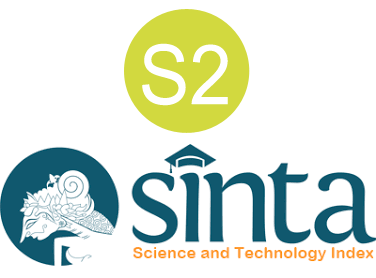Simbolisme Kakereb Barong Dan Rangda Dalam Upacara Butha Yadnya Di Desa Bitra Gianyar
DOI:
https://doi.org/10.37329/jpah.v9i4.4611Keywords:
Kakereb, Barong Rangda, Bhuta YadnyaAbstract
Kakereb is the veil used for Barong and Rangda, made from a square piece of white cloth measuring 1.2 meters by 1.2 meters. Its uniqueness lies in the sacred inscriptions (rerajahan) written on its surface. These inscriptions contain texts that represent a sacred symbolic system of Shaivite Tantric theology, encompassing the concept of Acintya (the inconceivable aspect of God) as well as sacred characters such as Ongkara and wijaksara. In addition to the textual elements, the kakereb also features symbolic images such as dragons, fire, weapons of the Dewata Nawasanga, and modre letters. The essential meaning behind the kakereb is that God (Shiva) is the essence that is both One and many (Eka-aneka). The One Supreme God (Eka), by His own will, manifests Himself into various deities and even into all that exists (sarwa). The kakereb, in relation to Barong and Rangda, symbolizes a theology of duality. God is glorified with the names Bhatara Shiva and Dewi Uma, who are considered the source, existence, and ultimate purpose of all things in the world. Shiva has a thousand names (sahasra nama), and so does Uma, illustrating the infinite aspects of their divinity. Thus, Balinese Hindus who follow the Shaivite Tantric tradition are not worshipping demons, but are in fact worshipping God through sacred and religious-magical forms such as Barong and Rangda. Although these figures may appear demonic on the surface, they are actually sacred embodiments known as Ratu Bagus and Ratu Ayu.
References
Avalon, A. (1997). Mahanirwana Tantra (Terj. K. Nila). Denpasar: Upada Sastra.
Bagiarta, I. N. (2022). Upacara Barong Nyatur Desa pada Sasih Kelima di Desa Adat Bitra, Gianyar. Denpasar: Program Magister Ilmu Agama dan Kebudayaan, Program Pascasarjana UNHI.
Bandem, N. L. N. S. W. (2014). Barong Kuntisraya: Icon Pertunjukan Bali Kontemporer. Denpasar: BP Stikom Bali.
Dana, I. W. (2010). Paruman Tapakan Barong dalam Ritual Napak Pertiwi. Yogyakarta: Prodi Seni Tari, ISI Yogyakarta.
Dev, A. (1995). Mudras for Healing. Haridwar: Drolia Books.
Djapa, I. W. (2013). Wrhaspati Tattwa. Denpasar: Program Pascasarjana UNHI.
Gautama, B. (2016). Aji Terus Tunjung. Gianyar: tanpa penerbit.
Hooykaas, C. (1974). Cosmogony and Creation in Balinese Tradition. The Hague: Martinus Nijhoff.
Karsana, I. N. (2012). Tarian Barong Ket dan Rangda dalam Upacara Pacaruan Sasih Kaenem di Desa Pakraman Tonja, Kota Denpasar: Perspektif Agama dan Kebudayaan. Denpasar: Program Magister Ilmu Agama dan Kebudayaan, Program Pascasarjana UNHI.
Sandika, I. K. (2019). Tantra Ilmu Jawa Kuno. Tangerang Selatan: Javanika.
Sandika, I. K. (2022). Sedulur Papat Kalima Pancer. Tangerang Selatan: Javanika.
Soebadio, H. (1985). Jnanasiddhanta. Jakarta: Djambatan.
Suarka, I. N., & Suteja, I. W. (2005). Kajian Naskah Lontar Siwagama (Vol. 2). Denpasar: Dinas Kebudayaan Provinsi Bali.
Suastika, I. M. (1997). Calon Arang dalam Tradisi Bali: Suntingan Teks, Terjemahan, dan Analisis Semiotik. Yogyakarta: Duta Wacana University Press.
Triguna, I. B. G. Y. (2000). Teori tentang Simbol. Denpasar: Widya Dharma.
Triguna, I. B. G. Y. (2023). Secularization of Sacred Art: Critical Reflections on Balinese Cultural Politics. Jurnal Kajian Bali, 13(2).
Triguna, I. B. G. Y., Arniati, I. A. K., & Wahyuni, I. A. K. S. (2025). Ritus: Ketahanan budaya dalam dinamika peradaban. Denpasar: Pustaka Larasan.
Wirawan. (2016). Keberadaan Barong dan Rangda dalam Dinamika Religius Masyarakat Hindu Bali. Surabaya: Paramita.
Wirawan. (2017). Pementasan Dramatari Calonarang di Kota Denpasar: Perspektif Teo-Estetika Hindu (Disertasi, Program Doktor Ilmu Agama, Pascasarjana IHDN Denpasar). Denpasar: IHDN Denpasar.
Yasa, I. W. S. (2013). Brahma Widya: Teks Tattwa Jnana. Denpasar: Fakultas Ilmu Agama, UNHI Denpasar.
Yasa, I. W. S. (2020). Wijaksara: Tuntunan Yoga Anak Nyastra Bali. Denpasar: Pascasarjana UNHI Denpasar.
Sukayasa, I. W., Gitananda, W. S., & Putra, I. G. A. D. (2023). BHUWANA KOSA: Pengetahuan mistis & Yoga Kapaóðitan. Denpasar: Sarwa Tattwa Pustaka
Zoetmulder, P. J. (1995). Kamus Jawa Kuna-Indonesia. Jakarta: Gramedia Pustaka Utama.
Downloads
Published
How to Cite
Issue
Section
License
Copyright (c) 2025 Ida Bagus Gde Yudha Triguna, I Nyoman Kembar Bagiarta, I Nyoman Sudanta

This work is licensed under a Creative Commons Attribution-ShareAlike 4.0 International License.
An author who publishes in the Jurnal Penelitian Agama Hindu agrees to the following terms:
- Author retains the copyright and grants the journal the right of first publication of the work simultaneously licensed under the Creative Commons Attribution-ShareAlike 4.0 License that allows others to share the work with an acknowledgement of the work's authorship and initial publication in this journal
- Author is able to enter into separate, additional contractual arrangements for the non-exclusive distribution of the journal's published version of the work (e.g., post it to an institutional repository or publish it in a book) with the acknowledgement of its initial publication in this journal.
- Author is permitted and encouraged to post his/her work online (e.g., in institutional repositories or on their website) prior to and during the submission process, as it can lead to productive exchanges, as well as earlier and greater citation of the published work (See The Effect of Open Access).
Read more about the Creative Commons Attribution-ShareAlike 4.0 Licence here: https://creativecommons.org/licenses/by-sa/4.0/.








